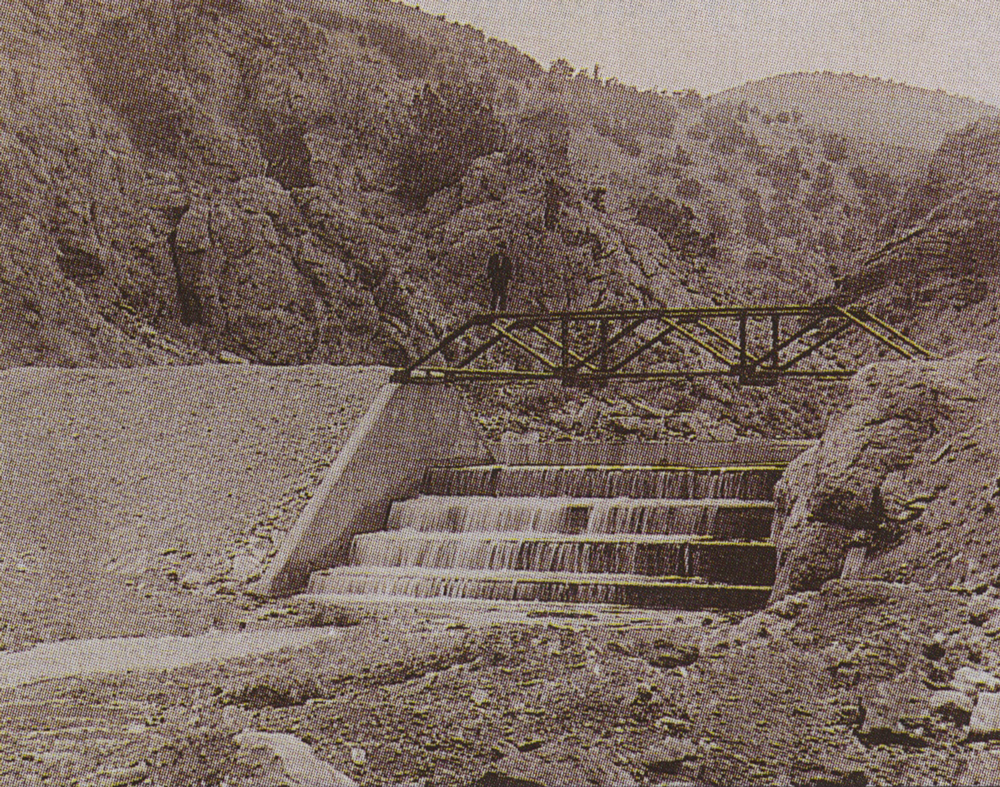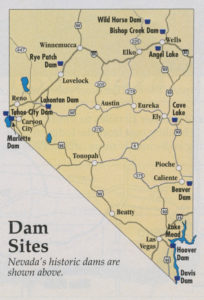Yesterday: Dam Historic Places
Summer 2021
Engineering wonders that hold back the tides of time
This story originally appeared in the September/October 1995 issue of Nevada Magazine.

Hoover Dam is Nevada’s most famous river barrier, but other dams in the state have historic foundations, too. In honor of Hoover’s 60th birthday, following are some of the Silver State’s most noteworthy dams.
 Wild Horse Dam: There are two Wild Horse dams. The first was built in 1937 to store Owyhee River water to irrigate hay meadows on the Duck Valley Indian Reservation, 60 miles north of Elko. In 1969, a larger dam was built upstream from the original dam-which still stands beneath the waters of Wild Horse Reservoir.
Wild Horse Dam: There are two Wild Horse dams. The first was built in 1937 to store Owyhee River water to irrigate hay meadows on the Duck Valley Indian Reservation, 60 miles north of Elko. In 1969, a larger dam was built upstream from the original dam-which still stands beneath the waters of Wild Horse Reservoir. - Bishop Creek Dam: Originally called the Metropolis Dam, this structure was built in 1912 for the farming community of Metropolis, 20 miles north of Wells. But downstream farmers won a lawsuit contesting the dam, and it has never been used to its full potential. The dam’s fill includes brick rubble from the 1906 San Francisco earthquake.
- Angel Lake: Built in the 1880s, this dirt-and-rock barrier is one of the state’s oldest dams and creates a picturesque alpine lake 12 miles south of Wells.
- Cave Lake: The earthen dam creating this scenic lake is so low-profile that most visitors don’t realize Cave Lake is a manmade reservoir. The lake was created by a rancher in the 1920s and enlarged in 1961 by the Nevada Division of State Parks. The state-record brown trout (27 pounds, five ounces) was caught here in 1984.
- Beaver Dam: Beaver Dam State Park is 34 miles east of Caliente, 28 miles by dirt road. The park’s namesake dam, built in 1961 to control flooding, is a plain, dirt wedge in a beautiful piñon and juniper setting. Visitors can fish and boat on Schroeder Reservoir.
- Davis Dam: With its blocky, angular design, this dirt-fill and concrete slab looks the way a dam ought to look. Located on the Colorado River, 67 miles downstream from Hoover Dam and a mile north of Laughlin, Davis Dam was built from 1946 to 1953 and created Lake Mohave.
- Lahontan Dam: This impressive concrete, earth, and rock dam has distinctive design touches, such as an elegant archway and suspension bridge leading to an outlet tower. Constructed in 1911-15 as part of the nation’s first reclamation project, the dam captures water from the Truckee and Carson rivers and feeds it to Fallon farms.
- Marlette Dam: Part of the oldest water system in Nevada, this dam was built on Marlette Lake, near Lake Tahoe, by a lumber company in the 1860s. A series of flumes and pipelines was built in 1877 to carry Marlette’s water to Virginia City. The system was one of the engineering marvels of the 19th-century West, transporting water down 2,700 feet to Washoe Valley, across the valley, and up 1,400 feet to Virginia City.
- Tahoe City Dam: Sitting at the north end of Lake Tahoe, this dam is the spigot that pours water into the Truckee River, which provides nearly all the household water for Northwestern Nevada. Built from 1909 to 1913 despite vehement opposition from shoreline-property owners, the 14-foot concrete dam raised Tahoe’s level more than six feet.
- Rye Patch Dam: This squat, concrete dam was built on the Humboldt River in 1935-36 to store irrigation water for downstream Lovelock farmers. The dam takes its name from the large patches of wild rye that once grew in the area, providing an important food source for livestock on the Emigrant Trail.
Richard Moreno is Nevada’s publisher. His latest book is “The Nevada Trivia Book,” published by Gem Guides.
